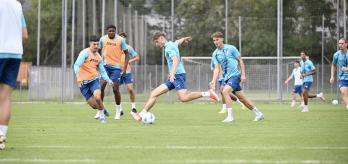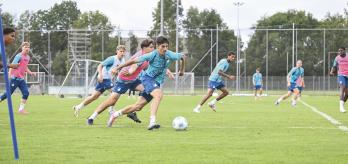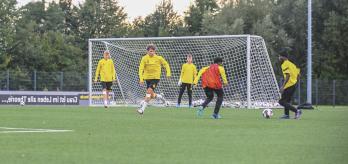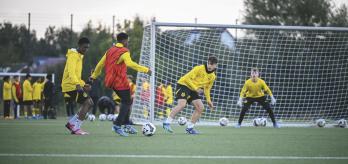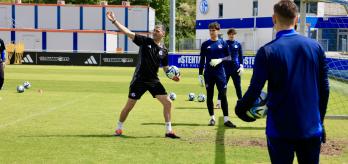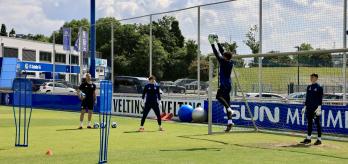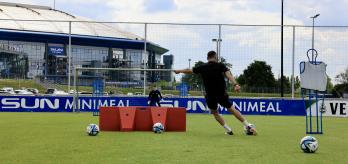The goalkeeper coach deliberately takes a back seat in these exercises – the head coach is in charge. He chooses the drills but gives the goalkeeper coach the freedom to continue working closely with and coaching his goalkeepers. The latter remains flexible, adapting to the head coach’s instructions while keeping his own focus.
Counter-attacking from a corner: 3v2
As in individual goalkeeper training, the goalkeeper first claims a cross. This time, however, real teammates join in and should be played in immediately. They then launch a counter-attack towards a goal defended by a goalkeeper.
-
In one half of the pitch, set up a goal with a goalkeeper at each end, six mannequins and two pole gates (width: approx. 12m) as shown.
-
The coach stands in one corner with a supply of balls.
-
Nominate 3 attackers and 1 defender.
-
The coach lofts crosses into the penalty area for the goalkeeper to claim.
-
The goalkeeper immediately initiates a counter-attack, with the offside rule applying.
-
A runs into the middle, while B and C each move out wide.
-
The goalkeeper rolls or throws the ball out (e.g. to A).
-
If they throw to B or C, the attack must pass through the corresponding pole gate.
-
If they win the ball, the defender can counter-attack towards the opposite goal.
-
After a while, the goalkeepers and players change roles and swap side
Counter-attacking from a corner: 9v9 plus 2
The next part is even more game-like: as with a corner or a cross, defenders and attackers put the goalkeeper under pressure. He must claim the high ball before initiating an attack on the opponent’s goal.
-
In one half of the pitch, set up a 35m area with a goal and a goalkeeper at each end, plus a central zone and two channels out wide (respectively 5m deep/wide).
-
Set up supplies of balls at the corners beyond the wide channels.
-
Form two teams of 9 players (including the goalkeepers).
-
Nominate 2 neutral players.
-
A 9v9 + 2 neutrals is contested with players in defined zones.
-
The exercise always begins/continues with a corner kick.
-
If the goalkeeper intercepts the corner kick, they immediately roll the ball to a neutral player or throw it to a winger, who can dribble or cross into the area.
-
The winger further from the ball can shift inside.
9v9 on four goals
After a realistic corner situation, play can switch into a counter-attack on two different goals. This challenges the goalkeeper’s awareness, as he must quickly find and play the teammate most likely to create a successful counter.
-
Split a full-size pitch into three zones (the two at either end should be 30m long and the middle one 40m long) with four goals in total, each with a goalkeeper.
-
Set up supplies of balls at the corners of the central zone.
-
Form two teams of 9 players (including the goalkeepers).
-
The exercise always begins/continues with a corner kick.
-
If the goalkeeper does not intercept this, a 9v9 is contested in the central zone.
-
However, if the goalkeeper does intercept it, they immediately initiate a counter-attack towards one of the goals at either end of the pitch (goal 3 or goal 4).
-
A goal after a counter-attack launched by the goalkeeper is worth three points.
-
When they intercept a corner kick, the goalkeeper must analyse the situation when deciding whether to roll the ball out, initiating the counter-attack by using the second wave (preferred solution), or to throw out wide and use the third wave.
-
If fewer goalkeepers are available, the goals situated at the ends of the pitch (goals 3 and 4) can be replaced with small goals or mini-goals.
From 3v4 to 3v3 or 5v5
In a three-goal exercise, the goalkeeper once again has to claim a corner under pressure before finding the teammate best placed to counter on one of two possible goals. These practices also help teammates improve their movement off the ball after a corner has been intercepted.
-
Mark out a three-quarter-length pitch with three goals, each with a goalkeeper, as well as a 7x40m zone at the edge of the penalty area (near goal 1).
-
Form two teams of 7 outfield players and position them as shown.
-
The coach stands in one corner with a supply of balls.
-
The coach crosses into the penalty area to create a 3v4 situation (three attackers against four defending players, including the goalkeeper).
-
Goals scored directly from the corner kick (i.e. headers, volleys) are worth three points and goals scored from rebounds/second balls after the corner kick are worth one point.
-
If the goalkeeper intercepts the cross, they immediately transition to initiate a counter-attack.
-
They roll the ball into the zone at the edge of the penalty area for an advancing team-mate or throw longer to the attackers on the wings.
- The previous attackers are required to stay within the penalty area.
-
The team then decide whether to attack 3v3 towards goal 2 (worth one point) or 5v5 towards goal 3 (worth three points).
-
If the other team win the ball, they can, in turn, counter-attack back towards goal 1.
-
If fewer goalkeepers are available, the goal situated three quarters up the pitch (goal 3) can be replaced with a small goal or mini-goal.




